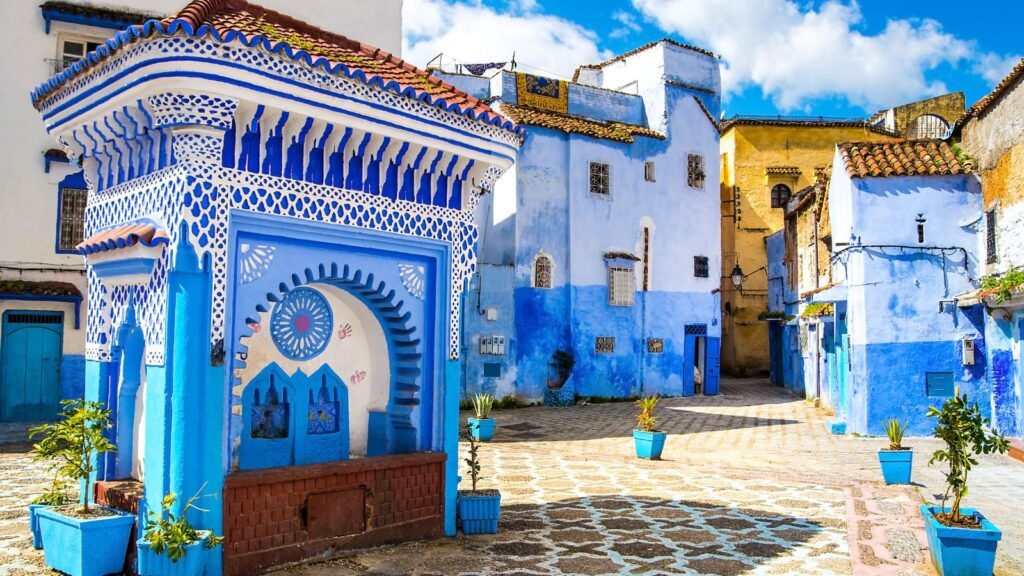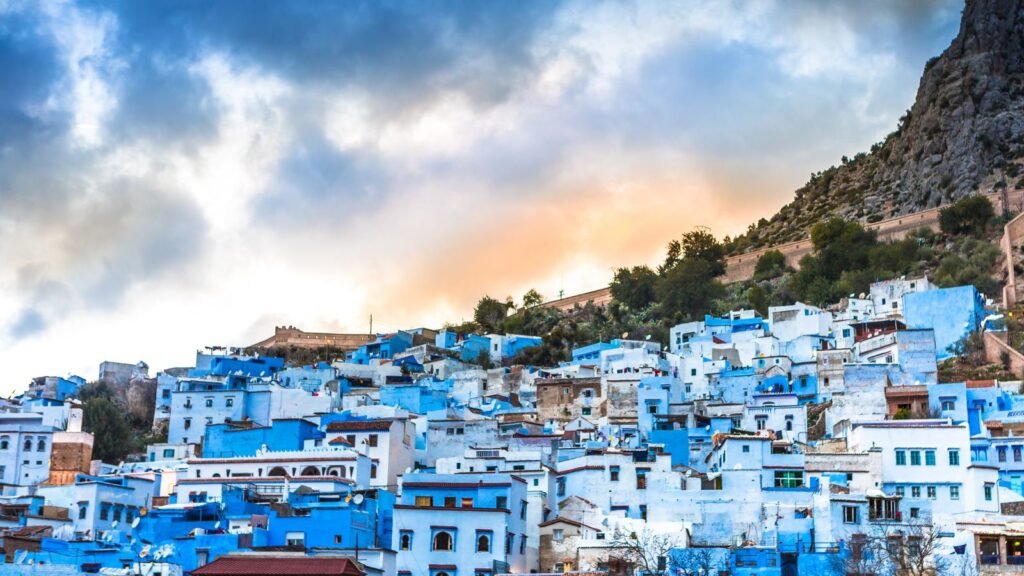Chefchaouen doesn’t just wear blue, it bathes in it with the unapologetic flair of someone who knows they look good in every shade. The entire town seems dipped in a collective dream of periwinkle, cobalt and turquoise, as if the sky decided to take a permanent holiday on earth. Nestled into the fold of the Rif Mountains like a painter’s final flourish, Chefchaouen is one of those places where the line between reality and fantasy gets charmingly blurry. It’s a maze of winding lanes, sleepy cats sunning themselves on stoops, and staircases that look like they were made for fairy tales and accidental epiphanies. The blue isn’t just paint—it’s a mood, a rhythm, a living language spoken in plaster and pigment.
The medina is the heart, and yes, it pulses blue. Not the chaotic kind of medina you brace yourself for in bigger cities, but something gentler, smaller, like someone whispered it into existence rather than built it. Every doorway is a photo waiting to happen, every alley a corridor of soft light and chipped paint. You’ll see shades you didn’t know existed. There’s periwinkle and indigo, of course, but also lavender, faded cerulean, and an occasional splash of sunflower yellow that looks positively rebellious. But don’t just take pictures. Stop. Watch a cat blinking in the sun. Listen to the rhythm of a distant broom sweeping stone. Breathe in the gentle dust of everyday life. It’s a town that invites you to participate in the art of being unhurried.

Chefchaouen moves slowly and unapologetically so. Mornings begin with the echo of the call to prayer rolling across the rooftops, the clatter of shutters opening, and the rustle of someone dragging a table into position. The local market springs up with baskets of plump tomatoes, apricots still dusted with their own fuzz, and mint—mountains of mint. There’s usually a man sitting beside a heap of olives in various hues, scooping them into plastic bags with an old tin cup, and someone else waving away flies from a stand of honey that may or may not be measured by eye and faith alone. You’ll find piles of herbs you can’t name but want to smell, and more varieties of cheese than you ever imagined could fit into a single basket.
You’ll want to climb up to the Spanish Mosque at some point, preferably in the late afternoon when the light starts doing poetic things to the town below. The walk is short but steep—enough to make you aware of every pastry you’ve consumed. But the view from the top is a marvel. The town lies below like a spilled box of blue crayons, with the mountains standing guard behind. The mosque itself is unassuming, often closed, but the plateau around it is a favourite for picnics, lazy chats, and dramatic Instagram posts. Stay for the sunset if you can. It’s not just pretty; it’s quietly breathtaking. Watch the colours shift and fade as the muezzin’s voice rises, floating out into the dusky air.

Back in town, the Kasbah sits in the centre like an old storyteller. Built in the 15th century, its walls are thick and vaguely conspiratorial, and the small museum inside is more about vibe than facts. The real charm lies in its garden, a green respite with orange trees, trickling fountains, and an air of dignified neglect. Climb the tower if only for the satisfaction of earning your next tea. It’s a place for sitting, not rushing. For letting the dust settle and the sound of trickling water smooth out your thoughts.
Speaking of tea, mint tea in Chefchaouen is not a drink, it’s a way of life. It’s offered everywhere, always slightly too sweet, always slightly too hot, and always served with a kind of ceremonial grace. Sip it slowly in a courtyard filled with tiles and bougainvillea, or on a rooftop where laundry flaps in the breeze. Café Clock is a good place for this—part cultural centre, part chill zone, with camel burgers if you’re feeling carnivorous and adventurous in equal measure. Or wander over to Aladdin Restaurant, where the name is kitsch but the view is pure magic. The tagines are the kind that smell like a promise kept. For something heartwarmingly humble, head to Bab El Souk, where locals gather for slow-cooked stews and you’re more likely to hear Amazigh than English.
Look out for the artisans, the quiet hands behind the town’s beauty. There are workshops where wool is dyed in steaming vats of colour so vivid it makes your own wardrobe look apologetic. Others hammer brass and carve wood in hypnotic rhythm, unfazed by the occasional tourist peeking in. You might stumble into a shop and come out with a blanket, a painted bowl, and a story you didn’t know you were collecting. You’ll see carpets drying in the sun, leather slippers laid out in bright rows, and weavers working under lantern light like time doesn’t exist. Ask questions, smile often, and you’ll find the stories are sometimes more valuable than the souvenirs.
If you want to escape the photo trail for a while, Ras El Maa is the place to wander. A natural spring just outside the medina, it’s where locals come to wash clothes, splash about, or simply sit with their feet in the water and a bag of sunflower seeds. The water is freezing, even in summer, but that doesn’t stop anyone. It’s a little haven of noise and light, a small reminder that life here isn’t just aesthetic—it’s real, lived, and gloriously messy. Further up, the sound of water thickens into a gurgling lullaby, and wildflowers peek out from under stones like shy children.
Beyond that, there are trails into the Rif Mountains, for those inclined to earn their tagine the hard way. You can hike to Akchour, a green paradise with waterfalls, swimming holes, and cafés perched beside streams serving tagine and mint tea with a view of actual goats climbing actual cliffs. It’s the kind of place that makes you want to delete your email app and live on olives and sunshine. There are also smaller paths out of town where you’ll meet no one but a shepherd and the occasional mule, paths where the silence rings like a bell and time stretches into something generous and wild.
Chefchaouen is not a checklist town. It’s not about ticking off landmarks or getting through an itinerary. It’s about slowing down. Saying yes to tea. Letting your feet decide which alley to take. Sitting still long enough to hear the fabric of the place: slippers on stone, the clink of glass, the low hum of someone singing to themselves in the distance. You don’t need a map. You just need time and maybe a scarf that matches the walls. Spend a day doing nothing, and you’ll find you’ve experienced everything. Spend a night listening to the quiet, and you’ll hear more than you thought you could.
And when you leave, you’ll scroll through your photos and think, “It can’t have been that blue.” But it was. And softer. And somehow brighter. And you’ll probably find a little bit of it stayed on your clothes, your hands, your memories. As if the town didn’t want you to forget. And you won’t. Not the light, not the quiet, not the feeling that for a brief moment, you were part of something slow and beautiful. You’ll carry that softness with you, a little piece of blue stitched into the seams of your travels.
